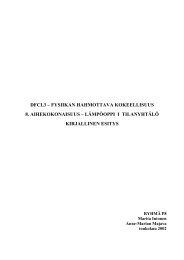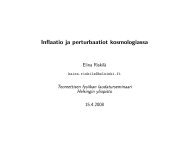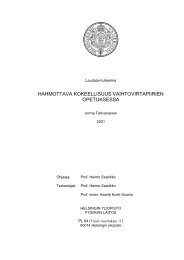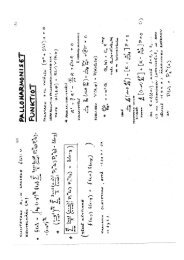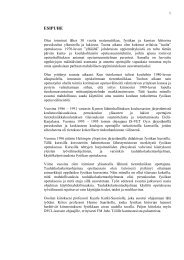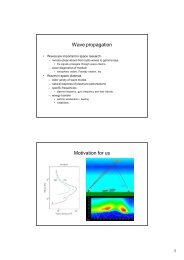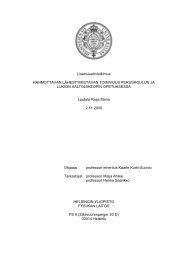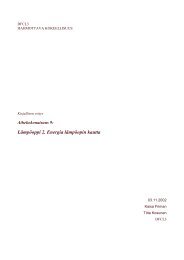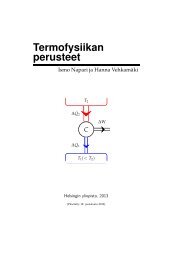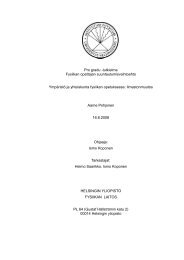Cosmological Perturbation Theory, 26.4.2011 version
Cosmological Perturbation Theory, 26.4.2011 version
Cosmological Perturbation Theory, 26.4.2011 version
You also want an ePaper? Increase the reach of your titles
YUMPU automatically turns print PDFs into web optimized ePapers that Google loves.
15 OTHER GAUGES 35A general perturbation at a given time can be decomposed into an adiabatic component,which has S = 0, and an isocurvature component, which has R = 0. Because of the linearityof first order perturbation theory, these components evolve independently, and the evolution ofthe general perturbation is just the superposition of the evolution of these two components, andthus they can be studied separately. Beware, however, that the ”adiabatic” component doesnot necessarily remain adiabatic in its evolution, and the ”isocurvature” component does notnecessarily maintain zero comoving curvature. We later show that adiabatic perturbations stayadiabatic while they are well outside the horizon.Adiabatic perturbations are important, since the simplest theory for the origin of structureof the universe, single-field inflation, produces adiabatic perturbations. Using the constancyof R, it is easy to follow the evolution of these perturbations while they are well outside thehorizon.Using Eq. (15.21) we can write the second line of Eq. (15.27) as− 3 2(1 + w)HR′ =Ψ ′′ + (2 + 3c 2 s )HΨ′ + HΦ ′ + 3(c 2 s − w)H2 Φ= 3 2 H2δp C¯ρ − 1 3 ∇2 (Φ − Ψ) (15.30)or (using Eq. 15.19)H −1 R ′( )= − δpC¯ρ + ¯p − 2 wδ31 + w ∇2 Π = −c 2 Cs1 + w − 3S − 2 w31 + w ∇2 Π (15.31)which is completely in the comoving gauge.15.5 Perfect Fluid Scalar <strong>Perturbation</strong>s, AgainWith Π = 0 ⇒ Ψ = Φ, Eqs. (15.18,15.19,15.20,15.21,15.22,15.23) become∇ 2 Φ = 3 2 H2 δ C (15.32)Φ ′ + HΦ = 3 2 H2 (1 + w)v N (15.33)Φ ′′ + 3(1 + c 2 s )HΦ′ + 3(c 2 s − w)H2 Φ = 3 2 H2δp C¯ρ(15.34)δ ′ C − 3Hwδ C = (1 + w)∇ 2 v N (15.35)v ′ N + Hv N = δp C¯ρ + ¯p + Φ . (15.36)and Eqs. (15.26,15.31) becomeRH −1 R ′2 (= −Φ − Φ ′ + HΦ ) (15.37)3(1 + w)H( )= − δpC δC¯ρ + ¯p = −c2 s1 + w − 3S (15.38)and Eq. (15.34) asH −2 Φ ′′ + 3(1 + c 2 s )H−1 Φ ′ + 3(c 2 s − w)Φ = 3 2 c2 s [δC − 3(1 + w)S]. (15.39)which is Eq. (12.16), with just ∇ 2 Φ replaced by δ C using Eq. (15.32). (I seem to be repeatinghere some material from Sec. 12.) Our aim is to get a differential equation with preferably just



